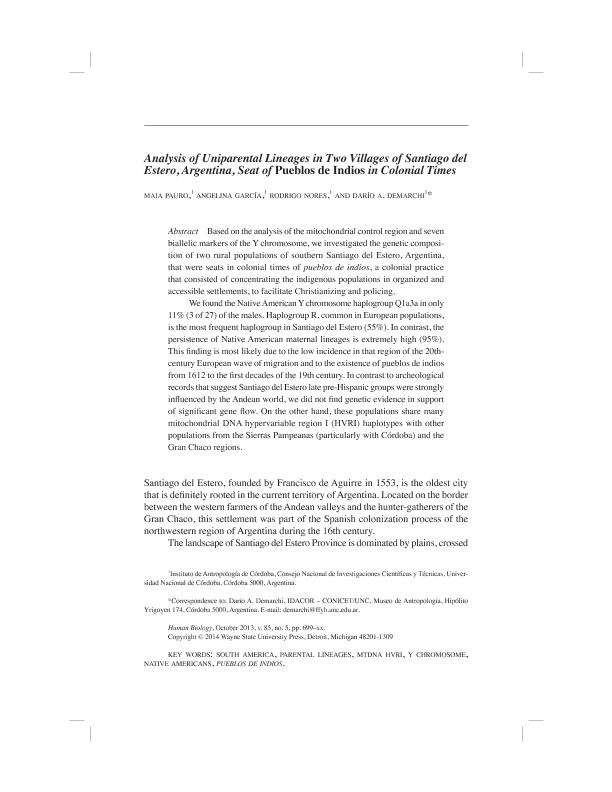Artículo
Analysis of Uniparental Lineages in Two Villages of Santiago del Estero, Argentina, Seat of Pueblos de Indios in Colonial Times
Fecha de publicación:
10/2013
Editorial:
Wayne State University Press
Revista:
Human Biology
ISSN:
0018-7143
Idioma:
Inglés
Tipo de recurso:
Artículo publicado
Clasificación temática:
Resumen
Based on the analysis of the mitochondrial control region and seven biallelic markers of the Y chromosome, we investigated the genetic composition of two rural populations of southern Santiago del Estero, Argentina, that were seats in colonial times of pueblos de indios, a colonial practice that consisted of concentrating the indigenous populations in organized and accessible settlements, to facilitate Christianizing and policing.
We found the Native American Y chromosome haplogroup Q1a3a in only 11% (3 of 27) of the males. Haplogroup R, common in European populations, is the most frequent haplogroup in Santiago del Estero (55%). In contrast, the persistence of Native American maternal lineages is extremely high (95%). This finding is most likely due to the low incidence in that region of the 20thcentury European wave of migration and to the existence of pueblos de indios from 1612 to the first decades of the 19th century. In contrast to archeological records that suggest Santiago del Estero late pre-Hispanic groups were strongly influenced by the Andean world, we did not find genetic evidence in support of significant gene flow. On the other hand, these populations share many mitochondrial DNA hypervariable region I (HVRI) haplotypes with other populations from the Sierras Pampeanas (particularly with Córdoba) and the Gran Chaco regions.
Archivos asociados
Licencia
Identificadores
Colecciones
Articulos(IDACOR)
Articulos de INSTITUTO DE ANTROPOLOGIA DE CORDOBA
Articulos de INSTITUTO DE ANTROPOLOGIA DE CORDOBA
Citación
Pauro, Maia; García, Angelina; Nores, Rodrigo; Demarchi, Dario; Analysis of Uniparental Lineages in Two Villages of Santiago del Estero, Argentina, Seat of Pueblos de Indios in Colonial Times; Wayne State University Press; Human Biology; 85; 5; 10-2013; 699-719
Compartir
Altmétricas




